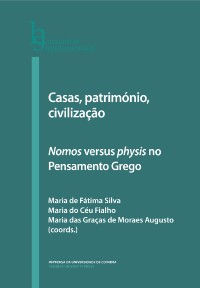Please use this identifier to cite or link to this item:
https://hdl.handle.net/10316.2/89442| DC Field | Value | Language |
|---|---|---|
| dc.contributor.author | Rodrigues, Nuno Simões | |
| dc.date.accessioned | 2019-11-27T14:17:16Z | |
| dc.date.accessioned | 2020-08-27T18:02:26Z | - |
| dc.date.available | 2019-11-27T14:17:16Z | |
| dc.date.available | 2020-08-27T18:02:26Z | - |
| dc.date.issued | 2019 | - |
| dc.identifier.isbn | 978‑989‑26‑1839‑5 (PDF) | |
| dc.identifier.isbn | 978‑989‑26‑1838‑8 | |
| dc.identifier.uri | https://hdl.handle.net/10316.2/89442 | - |
| dc.description.abstract | This essay analyzes the fragments of Euripides’ Chrysippus, as well as the iconographic representations of the topic, from the perspective of the ideas of phýsis and nómos. We have come to the conclusion that although Euripides apparently reinvented the myth in such a way as to characterize young Chrysippus's pederastic rape as intrinsically negative, thus integrating himself into the democratic values of Athens at that time, we cannot abandon the hypothesis that the poet may have maintained a subliminal reading of the myth. This reading would put the idea of hybris not in the pederastic act itself, but in the violation of hospitality, thus meeting the political agenda of a minority faction of the Athenian polis, but still present in the city: aristocracy. | eng |
| dc.description.abstract | Este estudo analisa os fragmentos do Crisipo de Eurípides, bem como as representações iconográficas do tema, sob a perspetiva das ideias de phýsis e nómos. Chegamos à conclusão de que, apesar de aparentemente Eurípides ter reinventado o mito de modo a caraterizar o rapto pederástico do jovem Crisipo como algo intrinsecamente negativo, integrando-se assim nos valores democráticos da Atenas de então, não podemos abandonar a hipótese de o poeta ter mantido uma leitura subliminar que colocaria a ideia de hybris não no ato pederástico em si, mas sim na violação da hospitalidade, indo assim ao encontro da agenda política de uma facção minoritária da polis ateniense, mas ainda assim presente na cidade: a aristocracia. | por |
| dc.language.iso | por | - |
| dc.publisher | Imprensa da Universidade de Coimbra | por |
| dc.rights | open access | - |
| dc.subject | Chrysippos | eng |
| dc.subject | Euripides | eng |
| dc.subject | rape | eng |
| dc.subject | pederasty | eng |
| dc.subject | xenia | eng |
| dc.subject | Crisipo | por |
| dc.subject | Eurípides | por |
| dc.subject | violação | por |
| dc.subject | pederastia | por |
| dc.subject | hospitalidade | por |
| dc.title | A violação de Crisipo à luz das ideias de phýsis e nómos | por |
| dc.title.alternative | Chrysippus' rape under the concepts of phýsis and nómos | eng |
| dc.type | bookPart | por |
| uc.publication.firstPage | 99 | - |
| uc.publication.lastPage | 115 | - |
| uc.publication.location | Coimbra | por |
| dc.identifier.doi | 10.14195/978‑989‑26‑1839‑5_6 | - |
| uc.publication.section | Nómos e phýsis na Antiguidade | por |
| uc.publication.digCollection | PB | por |
| uc.publication.orderno | 7 | - |
| uc.publication.area | Artes e Humanidades | por |
| uc.publication.bookTitle | Casas, património, civilização: nomos versus physis no pensamento grego | - |
| uc.publication.manifest | https://dl.uc.pt/json/iiif/10316.2/89442/198475/manifest?manifest=/json/iiif/10316.2/89442/198475/manifest | - |
| uc.publication.thumbnail | https://dl.uc.pt/retrieve/10970781 | - |
| uc.publication.parentItemId | 56738 | - |
| uc.itemId | 67690 | - |
| item.fulltext | With Fulltext | - |
| item.grantfulltext | open | - |
| Appears in Collections: | Casas, património, civilização: nomos versus physis no pensamento grego | |
Files in This Item:
| File | Description | Size | Format | |
|---|---|---|---|---|
| a_violacao_de_crisipo_a_luz_das_ideias_de_physis.pdf | 2.79 MB | Adobe PDF |  |
Items in DSpace are protected by copyright, with all rights reserved, unless otherwise indicated.
